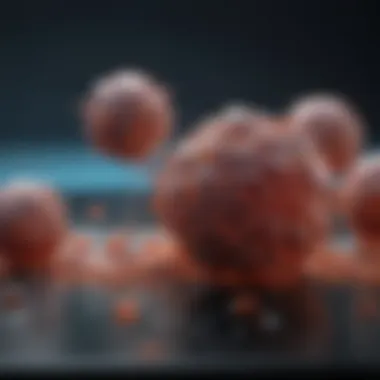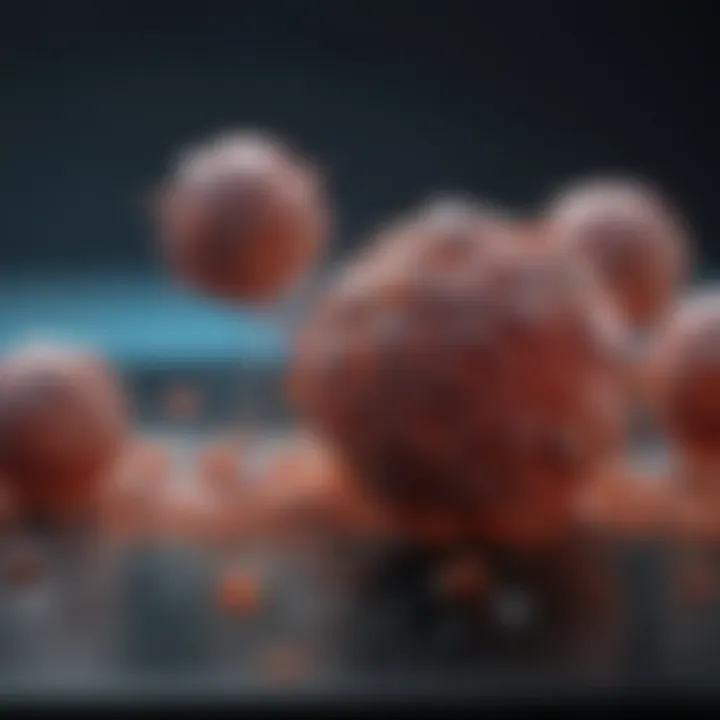Characterizing Monoclonal Antibodies: A Comprehensive Review


Overview of Research Topic
Brief Background and Context
Monoclonal antibodies are laboratory-produced molecules designed to bind to specific targets in the body, particularly in the field of medicine. These antibodies mimic the immune system's ability to fight off harmful pathogens such as viruses and bacteria. More significantly, they are pivotal in therapeutic applications for various diseases, including cancers and autoimmune disorders. The process of monoclonal antibody production involves the immunization of a host organism, usually a mouse, followed by the fusion of its spleen cells with myeloma cells to create hybridomas. This technique allows for the production of large quantities of identical antibodies, hence the name "monoclonal."
Through understanding the structure and function of these antibodies, researchers can manipulate them to improve efficacy and reduce side effects in patients. The role they play in modern medicine cannot be overstated, as they allow for precision medicine strategies tailored to individual patient needs.
Importance in Current Scientific Landscape
In recent years, the importance of monoclonal antibodies has surged due to advances in biotechnology. Not only have they proven essential in diagnostics, but they also provide targeted therapies that limit damage to healthy cells. These developments have opened new avenues in treatment protocols, increasing survival rates in many conditions. As such, awareness and understanding of how these antibodies work and how they can be characterized are crucial.
The characterization of monoclonal antibodies involves determining their stability, specificity, and overall functionality. Such knowledge is vital for regulatory approval and successful implementation in clinical settings. Thus, methodologies used in this characterization are of significant interest.
Methodology
Research Design and Approach
The study of monoclonal antibodies involves a combination of qualitative and quantitative research approaches. It includes designing experiments that assess the properties of these antibodies under various conditions. Analyses can range from understanding their binding affinities to evaluating their performance in real biological systems.
Quantitative analysis often focuses on measurements like concentration, purity, and bioactivity. Methods like enzyme-linked immunosorbent assays (ELISA) and flow cytometry provide precise data necessary for efficacy assessments. Experimental control is essential to distinguish between variations caused by different lots of antibodies or conditions used in assays.
Data Collection Techniques
Data collection involves various analytical techniques that can significantly impact understanding antibody characteristics. Common methods include:
- Affinity purification: It ensures that only antibodies that bind specifically to targets are retained for analysis.
- High-performance liquid chromatography (HPLC): This method separates and quantifies antibodies based on their size and charge properties.
- Mass spectrometry: Used to determine the molecular weight and structure of the antibodies, providing insights into their stability and degradation products.
- Biophysical methods: Techniques like circular dichroism (CD) and differential scanning calorimetry (DSC) assess the antibodies' folding and thermal stability.
Through these techniques, researchers can acquire comprehensive data pertaining to the behavior and functional capabilities of monoclonal antibodies in therapeutic applications.
Understanding the characterization of monoclonal antibodies is crucial for ensuring their safe and effective use in clinical practice.
Prolusion to Monoclonal Antibodies
Monoclonal antibodies have emerged as a cornerstone in the realms of therapeutics and diagnostics. This section elucidates their significance, origin, and current applications. Understanding monoclonal antibodies is critical for anyone involved in biomedical research or healthcare.
Definition and Origin
Monoclonal antibodies are identical copies of a single type of immune cell. They are produced by a single type of immune cell cloned in large numbers. The development of monoclonal antibodies began in the 1970s with the pioneering work of Georges Köhler and César Milstein. Their method involved fusing normally short-lived plasma cells with myeloma cells. The resulting hybridoma cells were capable of producing large quantities of specific antibodies. This technology has since evolved, leading to various methods of production such as recombinant DNA technology and other sophisticated cell culture techniques.
Importance in Therapeutics
Monoclonal antibodies have revolutionized the treatment of diseases such as cancer, autoimmune disorders, and infectious diseases. They allow for targeted therapy, meaning they can specifically bind to antigens present on disease cells or pathogens. This specificity reduces side effects and increases efficacy compared to traditional therapies. For instance, trastuzumab is a monoclonal antibody used in the treatment of HER2-positive breast cancer, displaying how these agents can transform patient outcomes dramatically. The ability to engineer monoclonal antibodies not only enhances therapeutic gain but also offers potential for personalized medicine, tailoring treatments to individual patient profiles.
Current Applications
Today, monoclonal antibodies are utilized widely in both therapeutics and diagnostics. In therapy, they serve diverse roles including direct cell targeting, immune enhancement, and delivering toxic agents directly to cancer cells. They have found applications in diseases like rheumatoid arthritis and various cancers. In diagnostics, assays like ELISA utilize monoclonal antibodies to detect specific biomarkers, providing valuable information for patient care. The landscape of monoclonal antibodies continues to expand, with ongoing research leading to new applications such as bispecific antibodies and antibody-drug conjugates, offering promising avenues for the future.
"Monoclonal antibodies are essential tools in modern medicine, providing precision in diagnostics and targeted therapies."
Understanding these foundational elements brings us closer to recognizing the transformative power of monoclonal antibodies in the medical field.
Monoclonal Antibody Production
Monoclonal antibody production is critical in the development and application of these powerful biological agents. Understanding the various methods for generating monoclonal antibodies gives insights into their efficacy and specific uses in therapeutics and diagnostics. Each production technique presents unique benefits and challenges, directly influencing the quality and performance of the antibodies generated.
The significance of mastering monoclonal antibody production lies in its implications for both research and clinical applications. The choice of production method affects not only the yield of antibodies but also their affinity, specificity, and overall functionality. As monoclonal antibodies continue to play an essential role in targeted therapies for various diseases, including cancers and autoimmune disorders, the methodologies employed in their production require thorough understanding.
Additionally, quality control measures during the production process are vital. These measures ensure that the resultant antibodies meet the necessary standards for use in clinical settings. Therefore, exploring different methods allows for advancements in the field, leading to improved therapeutic outcomes.
Hybridoma Technology
Hybridoma technology is the traditional method for monoclonal antibody production. It involves the fusion of B lymphocytes, which are antibody-producing cells, with myeloma cells, which are immortal and can replicate indefinitely. This process generates hybrid cells, known as hybridomas, that have the ability both to produce specific antibodies and to grow indefinitely.
This method is advantageous for producing antibodies with high specificity and affinity due to the selection of B cells that are already generating desired antibodies. The resulting hybridomas can be screened and cloned to select those that produce antibodies of interest. However, hybridoma technology also presents challenges, such as the time-consuming nature of the process and variable success rates in obtaining viable hybrid clones.


Recombinant DNA Technology
Recombinant DNA technology offers an alternative to hybridoma technology for producing monoclonal antibodies. This method involves genetic engineering techniques to create antibodies by inserting antibody genes into host cells, such as bacteria or yeast, enabling these cells to produce the desired antibodies.
This approach increases production efficiency and allows for the manipulation of antibody structure, which can enhance their efficacy. Moreover, recombinant technology facilitates the production of humanized or fully human antibodies, reducing the risk of immunogenic reactions in patients. However, the complexity of the genetic engineering processes can result in challenges related to the stability and correct folding of the produced antibodies.
Cell Culture Techniques
Cell culture techniques play an essential role in the production of monoclonal antibodies. These methods involve the growth of cells in controlled environments. Cell culture can be used in conjunction with both hybridoma and recombinant DNA technologies to optimize yields of antibody production.
Various types of cell culture systems, including adherent and suspension cultures, are employed, each with distinct benefits and limitations. For instance, suspension cultures can be scaled up more easily for large-scale production. Additionally, growing cells in a bioreactor can enhance the consistency and quality of the monoclonal antibodies produced. The choice of culture technique depends on factors such as scale, cost, and specific antibody requirements.
In summary, monoclonal antibody production involves a combination of established methods and innovative technologies tailored to meet the ever-evolving needs of modern medicine. The choice between hybridoma technology, recombinant DNA technology, and various cell culture techniques is influenced by the desired characteristics of the antibodies being produced. Understanding these production methods is key to advancing therapies that rely on the precise and efficient use of monoclonal antibodies.
Characterization Techniques
Understanding the characterization techniques for monoclonal antibodies is pivotal in assuring their efficacy and safety for therapeutic and diagnostic applications. These methods provide insight into the functional properties of antibodies, enabling researchers to assess their specificity, stability, and overall quality. When monoclonal antibodies are produced, a series of characterization techniques must be employed to validate their molecular profiles and confirm their intended use. Such techniques ensure that these biological agents meet stringent regulatory requirements and can perform reliably in clinical settings.
Affinity Measurement
Affinity measurement is critical to understand how effectively a monoclonal antibody binds to its target antigen. High affinity is often correlated with improved therapeutic effectiveness. Binding assays, like surface plasmon resonance and bio-layer interferometry, are commonly applied to quantify binding interactions. These assays help in determining the dissociation constant, Kd, which indicates the strength of binding between the antibody and antigen.
By evaluating affinity, researchers can predict the potential success of the antibody in practical applications. High-affinity antibodies may result in better-targeted therapies, leading to decreased dosages and reduced side effects for patients.
Immunogenicity Assessment
The immunogenicity of monoclonal antibodies refers to their ability to provoke an immune response in the body. This factor is crucial, as unexpected immune reactions can reduce the therapeutic efficacy and increase adverse effects. Various in vitro and in vivo assays exist to assess immunogenicity. These tests analyze the antibody’s structure and its potential epitopes that can trigger an immune response.
Monitoring the immunogenic signals is vital during clinical development. It helps identify potential issues early, ensuring the antibody can safely be used in patients without compromising health.
Stability Studies
Stability studies evaluate the shelf-life and structural integrity of monoclonal antibodies under different conditions. Stability is influenced by various factors, including temperature, light exposure, and pH levels. Techniques like accelerated stability testing and long-term storage studies are employed to assess the physical and chemical stability over time.
These studies play a significant role in formulating storage and distribution strategies. Understanding a monoclonal antibody's stability can prevent degradation and loss of efficacy before administration to patients. Maintaining a stable antibody is important for consistent therapeutic outcomes.
Purity Analysis
Purity analysis ensures that the monoclonal antibody preparations are free from contaminants, such as host cell proteins, DNA, or aggregate formations. Techniques such as high-performance liquid chromatography (HPLC) and sodium dodecyl sulfate–polyacrylamide gel electrophoresis (SDS-PAGE) are commonly utilized for this analysis. These methods allow for the assessment of the antibody's purity level and confirm its identity.
High purity is essential as impurities can impact the safety and effectiveness of the therapeutic agent. Ensuring that the monoclonal antibody is pure increases trust in its use for patients, lowering the risk of adverse reactions due to contaminants.
Effective characterization techniques not only guarantee the success of therapeutic applications but also uphold patient safety and public trust in biopharmaceutical products.
The implementtion of these detailed characterization techniques establishes a foundation upon which the efficacy, safety, and quality of monoclonal antibodies are built.
Analytical Methods
Analytical methods are crucial in characterizing monoclonal antibodies. They help ensure that these therapeutic agents are effective, safe, and of high quality. These methods support the development process, aiding researchers in understanding antibody properties. They are vital for compliance with regulatory standards, ensuring that the products meet the necessary criteria for clinical use.
Various analytical techniques exist, each with unique benefits. They can be used to assess the purity, stability, and activity of antibodies. Selecting the right method can significantly impact the outcomes of research and therapeutic applications. The following sections explore the primary analytical methods used in monoclonal antibody characterization.
ELISA (Enzyme-Linked Immunosorbent Assay)
ELISA stands as a fundamental technique for quantifying specific proteins, including monoclonal antibodies. It involves attaching an antigen to a solid surface, followed by the application of a sample containing antibodies. If the target antibodies are present, they will bind to the antigen, allowing for detection through a secondary enzyme-linked antibody. The resulting reaction produces a measurable signal, indicating the presence and amount of the original antibodies.
Some of the advantages of ELISA are:
- High sensitivity and specificity for detection.
- Ability to analyze multiple samples simultaneously.
- Quick and straightforward protocol, suitable for various laboratory settings.
However, it is essential to consider potential factors that can affect the results, such as assay conditions and the quality of reagents used.
Western Blotting
Western blotting is a technique that combines gel electrophoresis and immunodetection. It separates proteins based on size, allowing researchers to identify specific proteins, such as monoclonal antibodies. After separation, proteins are transferred to a membrane and probed with antibodies that bind specifically. This method provides essential information regarding the molecular weight and specificity of the antibodies.


Key points about Western blotting include:
- Capability to analyze complex mixtures of proteins.
- High specificity due to the use of various antibodies.
- Ability to confirm the presence of tagged or modified antibodies.
Nonetheless, careful optimization is needed for reliable interpretation of the results.
Mass Spectrometry
Mass spectrometry is a powerful tool for characterizing monoclonal antibodies at the molecular level. It provides detailed information about the mass, composition, and structure of the antibodies. By ionizing the sample and measuring the mass-to-charge ratio, researchers can obtain insights into molecular weights and post-translational modifications.
This technique offers several benefits, such as:
- High sensitivity and accuracy for detecting low-abundance proteins.
- Ability to assess protein structure and modifications.
- Capability to analyze complex biological samples.
Despite its advantages, mass spectrometry requires sophisticated equipment and expertise, limiting its accessibility in some laboratories.
Size Exclusion Chromatography
Size exclusion chromatography (SEC) is a separation technique widely used for analyzing the size distribution of monoclonal antibodies. It separates molecules based on their size as they pass through a column filled with porous beads. Larger molecules elute first, while smaller ones take longer to pass through the column. This method is essential for determining the homogeneity and oligomeric state of antibodies.
Main benefits of SEC include:
- Simple and reliable method for size characterization.
- Minimal sample preparation required.
- Non-destructive analysis, preserving the sample for further use.
However, proper calibration and method validation are necessary to achieve accurate results.
Regulatory Framework
The regulatory framework surrounding monoclonal antibodies is crucial to ensuring that these agents are safe and effective for use in therapeutic and diagnostic applications. Regulatory agencies such as the U.S. Food and Drug Administration (FDA) and the European Medicines Agency (EMA) set stringent guidelines to assess the quality, safety, and efficacy of monoclonal antibodies. Adherence to these regulations not only fosters public confidence but also builds a robust foundation for the development and commercialization of these biologics. Key elements of the regulatory framework include rigorous testing protocols, comprehensive documentation, and ongoing monitoring of the products post-marketing. This oversight is vital for addressing any emerging safety concerns and ensuring that the benefits of monoclonal antibodies continue to outweigh their risks.
FDA Guidelines
The FDA has established a well-defined pathway for the development and approval of monoclonal antibodies. Among the important guidelines, the Biologics Control Act lays out the requirements for biological products. The FDA mandates a detailed dossier from manufacturers, which includes information about the source of the antibodies, methods of production, characterisation data, clinical trial results, and proposed labeling. Most importantly, preclinical studies are crucial, providing essential data before any human trials can begin. The guidelines emphasize:
- Quality Control: Ensuring consistency in production and purity of the antibodies.
- Efficacy Demonstration: Comprehensive evidence that the antibodies effectively target specific antigens associated with diseases.
- Safety Assessments: Evaluations of potential adverse effects during clinical trials.
"Effective regulation ensures that monoclonal antibodies evolve as a safe and beneficial part of modern medicine, emphasizing science over speculation."
EMA Recommendations
The EMA's approach to monoclonal antibodies mirrors the FDA’s emphasis on rigorous testing and quality assurance. The agency advocates for a thorough Scientific Advice service, aiming to assist developers in designing robust clinical trials. Recommendations typically cover aspects such as:
- Preclinical Testing: Encouragement of comprehensive in vitro and in vivo studies to assess efficacy and safety.
- Clinical Trial Design: Guidelines for trial phases, including dosing strategies and patient selection.
- Post-Market Surveillance: Continuous monitoring once the monoclonal antibodies are in the market, assisting in early detection of unforeseen complications.
The EMA also stresses the importance of pharmacovigilance, ensuring that potential safety issues are reported and managed effectively.
Global Regulatory Considerations
As monoclonal antibodies become increasingly important worldwide, global regulatory considerations must be taken into account. Various international bodies, such as the World Health Organization (WHO), provide frameworks that harmonize regulations across different regions.
Specific factors to consider include:
- Harmonization: Efforts to align guidelines among regions can facilitate smoother market entry for monoclonal antibodies.
- Variability in Guidelines: Understanding the differences in regulations across various jurisdictions, which can impact timelines for product approval.
- Collaborative Approaches: Promoting collaboration between regulatory agencies globally to harmonize data requirements for clinical trials.
In summary, the regulatory framework is essential in guiding the safe and effective integration of monoclonal antibodies into therapeutic regimens. Adhering to these guidelines not only safeguards patient health but also enhances the scientific credibility of these important biologics.
Clinical Relevance
The clinical relevance of monoclonal antibodies cannot be understated. These agents serve pivotal roles in both therapeutic and diagnostic settings. Understanding their implications provides insight into the complex landscape of modern medicine. In this section, we will explore therapeutic applications, diagnostic uses, and the comparisons between monoclonal and polyclonal antibodies.
Therapeutic Applications
Monoclonal antibodies have revolutionized treatment protocols for various diseases, particularly in fields such as oncology, immunology, and infectious diseases. Their ability to specifically target antigens makes them highly effective in treatments. For instance, trastuzumab is significant in targeting HER2-positive breast cancer. Furthermore, monoclonal antibodies can be engineered for enhanced specificity and reduced side effects compared to conventional therapies.
The use of monoclonal antibodies extends to autoimmune diseases as well. Medications like adalimumab have transformed rheumatoid arthritis management. By inhibiting specific pathways of the immune response, they reduce inflammation and slow disease progression.


Moreover, monoclonal antibodies are also prominent in the domain of personalized medicine, allowing treatments to be tailored based on individual patient profiles. This targeted approach can lead to more effective and safer outcomes.
Diagnostic Uses
In addition to therapeutic applications, monoclonal antibodies play a considerable role in diagnostics. Their specificity allows for precise detection of biomarkers associated with various conditions. Tests like ELISA utilize monoclonal antibodies for identifying diseases rapidly and accurately. For instance, the detection of HIV antibodies in blood samples is achieved using these methods.
Additionally, monoclonal antibodies are instrumental in imaging techniques. Radiolabeled antibodies can facilitate tumor localization via imaging studies. This advanced diagnostic capacity aids in timely decisions in clinical settings, potentially improving patient outcomes.
Comparison with Polyclonal Antibodies
When comparing monoclonal antibodies to their polyclonal counterparts, several factors define their applications and usage. Monoclonal antibodies, produced from a single cell line, offer uniformity in specificity. This leads to consistent and reproducible results. In contrast, polyclonal antibodies, derived from multiple cell lines, have a broader range of reactivity but may lead to variability in results.
Key Differences Include:
- Specificity: Monoclonal antibodies target a single epitope while polyclonal antibodies can bind multiple epitopes.
- Consistency: Monoclonal antibodies are reliable due to their uniformity, whereas variations may occur with polyclonal antibodies.
- Production: The generation of monoclonal antibodies is more controlled, typically going through hybridoma technology, while polyclonal antibodies are easier and quicker to produce.
In summary, the clinical relevance of monoclonal antibodies extends across therapeutic and diagnostic arenas, shedding light on their essential functions in modern medicine. Their unique characteristics and capabilities outline their significance over polyclonal antibodies, ensuring a valuable role in patient care and treatment strategies.
"Monoclonal antibodies serve as a foundation for advancements in both therapeutic intervention and diagnostic accuracy, demonstrating the depth of their clinical relevance."
For further reading, you can visit Wikipedia to expand your knowledge.
Emerging Trends
Emerging trends in the field of monoclonal antibodies are pivotal for understanding the direction of therapeutic advancements. This section highlights the importance of these trends, focusing on innovative treatments, novel research avenues, and potential benefits to patient care. Recognizing these trends is essential for students, researchers, educators, and professionals alike, as they can have far-reaching implications in both clinical settings and research laboratories.
Bispecific Antibodies
Bispecific antibodies have gained significant attention due to their unique ability to bind to two different antigens simultaneously. This characteristic allows for targeted therapeutic action, enhancing efficacy in treatments such as cancer immunotherapy. By bridging immune cells with tumor cells, bispecific antibodies like Blinatumomab can initiate an immune response that is both more precise and potent. The development of these antibodies offers new hope for patients with complex diseases where traditional monoclonal antibodies may fall short.
- Mechanism of Action
- Clinical Successes
- Binding two distinct targets
- Facilitating T-cell activation
- Enhancing cytotoxic effects
- Treatment of acute lymphoblastic leukemia
- Potential applications in solid tumors
Antibody-Drug Conjugates
Antibody-drug conjugates (ADCs) epitomize the fusion of targeted therapy with chemotherapy. These innovative structures consist of a cytotoxic drug linked to a monoclonal antibody, directed toward specific tumor antigens. This design allows the delivery of potent drugs directly to cancer cells while minimizing exposure to healthy tissues. FDA-approved ADCs such as Trastuzumab emtansine demonstrate this principle, marking a significant evolution in cancer treatment strategies.
- Key Benefits of ADCs
- Increased specificity for cancer cells
- Reduced side effects compared to traditional chemotherapy
- Improved therapeutic outcomes and overall survival rates
The ongoing research into optimizing the drug-to-antibody ratio and enhancing linker stability is crucial for improving ADC efficacy and safety profiles.
Future Directions in Research
As the landscape of monoclonal antibodies continues to evolve, future research avenues are emerging that could redefine their application. One area is the exploration of combination therapies that leverage monoclonal antibodies alongside other treatment modalities such as checkpoint inhibitors or CAR T-cell therapy. This multifaceted approach may yield synergistic effects leading to more effective treatments.
Additionally, there is a growing focus on personalized medicine, tailoring therapies to the genetic and molecular profiles of individual patients. This personalized approach will require advanced biomarker identification and validation to effectively predict patient responses.
"The future of monoclonal antibodies lies in innovation and collaboration across disciplines to overcome existing challenges."
In summary, emerging trends like bispecific antibodies and antibody-drug conjugates represent significant strides in the field. They promise to enhance therapeutic efficacy and patient outcomes. Future research will continue exploring innovative strategies that aim to provide more tailored therapies, ultimately transforming the clinical landscape for diseases once deemed challenging to treat.
Finale
The topic of the conclusion serves as a vital component in understanding the significance of monoclonal antibody characterization. Through established methodologies and their implications in both therapeutic and diagnostic contexts, the conclusion synthesizes key findings from the article. It underlines how characterization not only ensures efficacy but also enhances safety in clinical applications.
Summary of Key Points
In summarizing key points, it is important to address the multifaceted nature of monoclonal antibody characterization. This includes:
- Importance of Affinity Measurement: Understanding how well an antibody binds to its target aids in determining its therapeutic effectiveness.
- Role of Immunogenicity Assessment: Evaluating how the immune system reacts to these antibodies is critical for patient safety.
- Stability and Purity: Ensuring that antibodies maintain their functional and structural integrity through various storage and handling conditions informs their clinical use.
Implications for Future Research
The implications for future research focus on several critical aspects:
- Advancements in Analytical Techiques: Continued development of novel techniques like mass spectrometry and advanced chromatography formats may provide deeper insights into antibody characterization.
- Tailoring Antibodies for Specific Diseases: Research can explore designing monoclonal antibodies that are not only effective but also compatible with individual patient profiles.
- Real-World Application in Diverse Settings: Investigating the practical use of monoclonal antibodies across various healthcare systems and environments can illuminate areas for improvement and optimization.
By emphasizing these points in the conclusion, the article fosters a clearer understanding of the field and invites ongoing inquiry into the evolving landscape of monoclonal antibodies.



